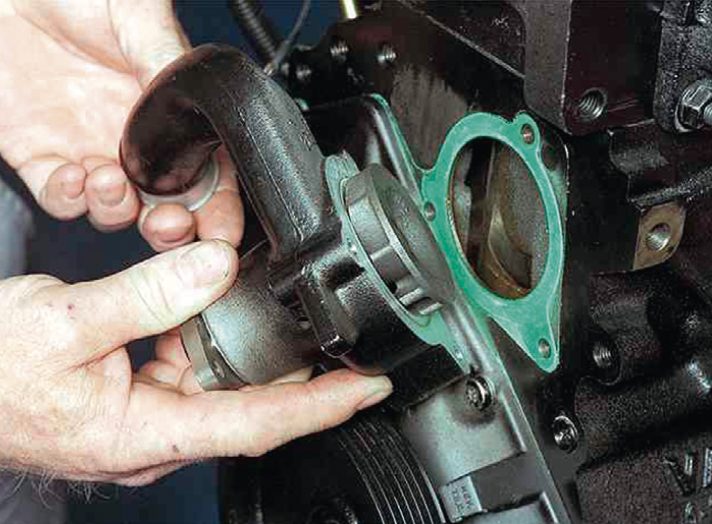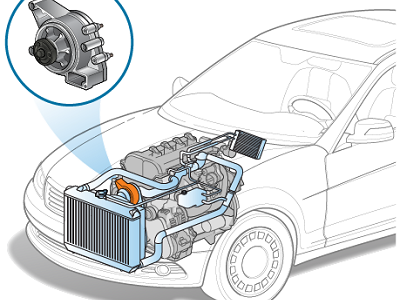Introduction:
Water pumps play a crucial role in the proper functioning of an engine. They are responsible for circulating coolant throughout the engine to keep it at the correct operating temperature. The position of the water pump in the engine block is critical to its effectiveness. In this blog post, we will discuss the importance of water pump positioning in an engine block.
Water Pump Function:
Before we dive into the topic of water pump positioning, let’s briefly discuss its function. A water pump is a mechanical device that circulates coolant through the engine block and radiator. It’s typically driven by a belt attached to the crankshaft. The coolant absorbs heat from the engine and then passes through the radiator where it’s cooled by air. The cooled coolant then returns to the engine block to repeat the cycle.
Importance of Water Pump Positioning:
The position of the water pump in the engine block is crucial to its effectiveness. If it’s positioned too high, it may not be able to circulate coolant properly through the engine. This can lead to overheating and engine damage. On the other hand, if it’s positioned too low, it may not be able to draw coolant efficiently from the radiator, which can also lead to overheating.
In addition to the vertical position, the horizontal position of the water pump is also essential. It needs to be mounted in such a way that it can provide proper flow of coolant through the engine block. Improper mounting can cause air pockets to form, which can prevent proper flow and cause overheating.
Water Pump Types:
There are two primary types of water pumps – the centrifugal pump and the positive displacement pump. Centrifugal pumps are the most common and are typically used in most automobiles. They work by spinning an impeller that creates a low-pressure zone, drawing coolant into the pump and pushing it through the engine block. Positive displacement pumps, on the other hand, use a series of gears or lobes to force coolant through the engine. They are more common in diesel engines.

Conclusion:
In conclusion, the position of the water pump in an engine block is critical to its effectiveness. It needs to be positioned correctly to provide proper flow of coolant through the engine block and radiator. Improper positioning can lead to overheating and engine damage. Water pumps come in two primary types, centrifugal and positive displacement, each with its own benefits and applications. Regular maintenance and inspection of the water pump can help prevent costly engine repairs and keep your vehicle running smoothly.
Vertical Positioning: As mentioned earlier, the vertical positioning of the water pump is crucial to its effectiveness. The water pump needs to be positioned high enough to be able to draw coolant from the radiator and low enough to be able to circulate the coolant through the engine block. In most engines, the water pump is positioned on the front of the engine block, driven by a belt that’s attached to the crankshaft.
One common issue that can arise from improper vertical positioning of the water pump is cavitation. Cavitation occurs when the coolant temperature gets too hot, causing bubbles to form in the coolant. These bubbles can create a low-pressure zone around the water pump impeller, preventing proper flow of coolant through the engine. Over time, this can lead to engine damage.
Horizontal Positioning: The horizontal positioning of the water pump is also important. The water pump needs to be mounted in such a way that it can provide proper flow of coolant through the engine block. If it’s mounted at an angle, air pockets can form, preventing proper flow of coolant and causing overheating.
In some engines, the water pump is mounted on the side of the engine block. In this case, it’s important to ensure that the pump is mounted at the correct angle to avoid air pockets. Some water pumps have a built-in bypass valve that helps to reduce the risk of air pockets forming.
Water Pump Maintenance: Regular maintenance and inspection of the water pump can help prevent costly engine repairs and keep your vehicle running smoothly. Some common signs that the water pump may be failing include coolant leaks, noise coming from the water pump, and overheating. If you notice any of these symptoms, it’s important to have the water pump inspected by a professional mechanic.
In addition to regular inspection, it’s also important to replace the water pump according to the manufacturer’s recommended maintenance schedule. Over time, the water pump can wear out, leading to decreased efficiency and potential engine damage.
Water Pump Types: There are two primary types of water pumps – centrifugal and positive displacement. Centrifugal pumps are the most common and are typically used in most automobiles. They work by spinning an impeller that creates a low-pressure zone, drawing coolant into the pump and pushing it through the engine block. Positive displacement pumps, on the other hand, use a series of gears or lobes to force coolant through the engine. They are more common in diesel engines.
In conclusion, the position of the water pump in the engine block is critical to its effectiveness. It needs to be positioned correctly to provide proper flow of coolant through the engine block and radiator. Regular maintenance and inspection of the water pump can help prevent costly engine repairs and keep your vehicle running smoothly. Understanding the different types of water pumps available and their applications can also help you make informed decisions when it comes to selecting the right water pump for your vehicle.
Advantages of Proper Water Pump Positioning:
- Proper cooling: Proper positioning of the water pump ensures that the coolant is circulated efficiently throughout the engine block and radiator, which helps maintain the engine temperature at a safe and optimal level. This helps prevent overheating and engine damage.
- Improved performance: A well-positioned water pump can improve the engine’s performance by ensuring that the coolant is distributed evenly and efficiently throughout the engine block. This helps prevent hotspots and reduces the risk of engine knock, which can negatively impact performance.
- Extended engine life: Proper water pump positioning can help extend the life of the engine by preventing overheating and other types of engine damage that can result from inefficient cooling.
Disadvantages of Improper Water Pump Positioning:
- Engine damage: Improper positioning of the water pump can cause hotspots in the engine block, which can lead to engine damage over time. This can be costly to repair or even result in the need for a new engine.
- Decreased performance: If the water pump is not positioned correctly, it may not be able to circulate the coolant efficiently through the engine block, which can negatively impact engine performance.
- Reduced lifespan: Inefficient cooling due to improper water pump positioning can cause increased wear and tear on the engine, which can shorten its lifespan.
- Costly repairs: If the water pump is not positioned correctly, it can lead to overheating and other types of engine damage that can be costly to repair. Regular maintenance and inspection of the water pump can help prevent these types of issues.
Conclusion: Proper water pump positioning is essential for efficient engine cooling, improved performance, and extended engine life. Improper positioning can result in engine damage, decreased performance, reduced lifespan, and costly repairs. Regular maintenance and inspection of the water pump can help prevent these issues and ensure that your vehicle runs smoothly for years to come.









